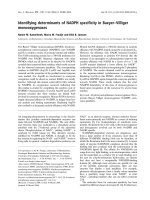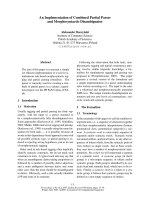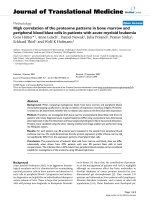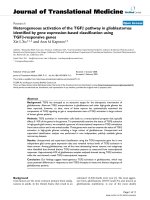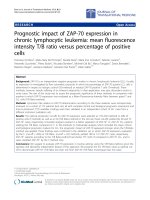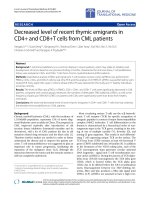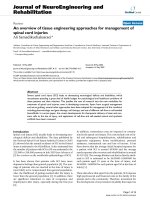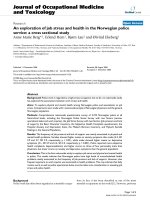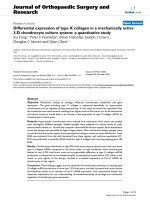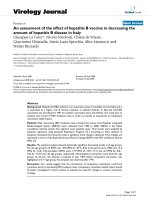Báo cáo hóa học: " An Implementation of Nonlinear Multiuser Detection in Rayleigh Fading Channel" docx
Bạn đang xem bản rút gọn của tài liệu. Xem và tải ngay bản đầy đủ của tài liệu tại đây (944.14 KB, 9 trang )
Hindawi Publishing Corporation
EURASIP Journal on Wireless Communications and Networking
Volume 2006, Article ID 45647, Pages 1–9
DOI 10.1155/WCN/2006/45647
An Implementation of Nonlinear Multiuser D etection in
Rayleigh Fading Channel
Wai Yie Leong,
1, 2
John Homer,
1
and Danilo P. Mandic
2
1
School of Information Technology and Electrical Engineering, The University of Queensland, Brisbane, QLD 4072, Australia
2
Communications and Signal Processing Group, Department of Electrical and Electronic Engineering, Imperial College London,
South Kensington Campus, London SW7 2 AZ, UK
Received 14 May 2005; Revised 12 December 2005; Accepted 6 February 2006
Recommended for Publication by David I. Laurenson
A blind nonlinear interference cancellation receiver for code-division multiple-access- (CDMA-) based communication systems
operating over Rayleigh flat-fading channels is proposed. The receiver which assumes knowledge of the signature waveforms of all
the users is implemented in an asynchronous CDMA environment. Unlike the conventional MMSE receiver, the proposed blind
ICA multiuser detector is shown to be robust without training sequences and with only knowledge of the signature waveforms.
It has achieved nearly the same performance of the conventional training-based MMSE receiver. Several comparisons and exper-
iments are performed based on examining BER performance in AWGN and R ayleig h fading in order to verify the validity of the
proposed blind ICA multiuser detector.
Copyright © 2006 Wai Yie Leong et al. This is an open access article distributed under the Creative Commons Attribution License,
which permits unrestricted use, distribution, and reproduction in any medium, provided the original work is properly cited.
1. INTRODUCTION
In mobile communication systems, multiuser detection is
also known under the names of cochannel interference sup-
pression, multiuser demodulation, or interference cancella-
tion, and requires rather complicated high-precision power
control. The design of multiuser detectors has been mo-
tivated by the channel environment encountered in many
CDMA applications, for channels with fading, multipath, or
noncoherent modulation have been considered [1, 2]. In par-
ticular, recent focus has been on the blind (or non-data-
aided) multiuser detectors such as SIC [3], PIC [4], and
DFD [5], these require no training data sequence, but only
knowledge of the desired user signature sequence and its tim-
ing [6]. The main motivation of employing a blind mul-
tiuser detector in CDMA is to recover the original sequence
from the received signal that is corrupted by noise and MAI,
without the help of training sequences and a priori knowl-
edge of the channel. Prior work by Ristaniemi and Jout-
sensalo [7] leads to the proposal of two types of receivers,
RAKE-ICA and MMSE-ICA, in a Rayleigh fading channel
using the modified FastICA algorithm [8]. However, the es-
timation of eigenvectors and eigenvalues becomes an addi-
tional burden for the proposed RAKE-ICA. Also, the MMSE-
ICA which required training sequences causes an increase in
computational load. An adaptive multiuser detector, which
converges to the MMSE detector without requiring train-
ing sequences, is proposed in [1]. This detector is designed
with incomplete knowledge of the received signature wave-
form of the desired user. In [9], a blind adaptive multiuser
detector based on Kalman filtering for both stationary and
slowly time-varying environments has been proposed, and
it is shown that the steady-state excess output energy of the
Kalman filtering algorithm is strictly zero for a statistically
stationary environment. A overview of adapt ive tentative-
decision-based detectors is given by Verdu in [2]. It was men-
tioned that a linear MMSE detector has the features of a
decorrelating detector, except that it requires knowledge of
the received amplitudes. On the other hand, the tentative-
decision-based multiuser detector is the simplest idea for
successive cancellation, but its disadvantage is that it re-
quires extremely accurate estimation of the received ampli-
tudes [2, 10]. The work of Verdu has also provided an excep-
tionally important reference and guide for the implementa-
tion of the subsequent work.
The objective of this paper is to introduce a blind mul-
tiuser detector that adaptively recovers signals from multi-
ple users. The proposed blind multiuser detector is capable
of replacing the conventional MMSE detector which requires
training sequences and the original transmitted signals. This
2 EURASIP Journal on Wireless Communications and Networking
is achieved based on independent component analysis (ICA)
[11, 12] used at the outputs of a bank of matched filters.
The rest of this paper is organized as follows. Section 2
describes the CDMA communication model and decision
statistics. This is fol lowed by an introduction of the pro-
posed ICA algorithm in Section 3. Performance analysis and
simulation results are presented in Section 4 to demonstrate
the performance of the new proposed detector and make
a comparison with the other conventional detectors. Fi-
nally, discussions and conclusions are given in Section 5 and
Section 6.
2. BACKGROUND
2.1. Multiuser communication model
Let us first derive the decision statistic for the proposed blind
nonlinear multiuser receiver structure. The main principle
of the receiver is that for a given decoding order, the re-
ceived signal is first passed through a correlator. The soft out-
put of the correlator is then used to detect the first signal.
We present expressions for the probability of the bit error
for an AWGN channel with constant (although not necessar-
ily equal) received user energies. These analytical results are
then compared with simulation results.
2.2. System model
Consider a time-invariant flat-fading asynchronous uplink
CDMA channel. The received baseband signal, r(t), in an an-
tipodal K-user BPSK modulated system is given by
r(t)
=
J
i=−J
K
k=1
g
k
A
k
b
k
(i)s
k
t − iT
s
− τ
k
+ σn(t), (1)
where 2J + 1 denotes the number of data symbols per user
per frame.
(i) g
k
is the channel gain for the kth user.
(ii) A
k
is the transmitted amplitude of the kth user.
(iii) b
k
(i) is the ith (independent binary input) data symbol
of the kth user, b
k
∈{−1, +1}.
(iv) The kth signature waveform s
k
is determined by the
random pseudonoise (PN) spreading sequence c
k
and
pulse-shape waveform p(t), given by
s
k
(t) =
N
PG
−1
i=0
c
k
(i)p
t − iT
c
for 0 ≤ t ≤ T
s
,
s
k
(t) = s
k
t − mT
s
for t otherwise,
where m
= integer,
(2)
where s
k
(t) is assumed to have unit energy over the
symbol interval: T
s
= N
PG
T
c
symbol interval; T
c
chip
interval; N
PG
processing gain.
In this work, s
k
is genera ted by Gold code sequences.
These signature sequences are independent of the data
symbols and have a chip rate much higher than the
symbol rate.
(v) The kth signature waveform s
k
is assumed to have unit
energy (
T
0
|s
k
|
2
dt = 1).τ
k
∈ [0, T
s
) is the kth user’s
relative time offset, where T
s
is the symbol period.
(vi) The additive white Gaussian noise n( t) has unit power
spectr al density.
(vii) σ
2
is the variance of the additive noise.
We assume completely asynchronous transmission. In
this context, when there are timing errors, each user’s code
experiences a random delay during the transmission and the
received signal is no longer aligned with the locally gener ated
codes [13]. We consider the received signal r(t) over only one
symbol period that is asynchronous to the desired user.
2.3. Correlator and crosscorrelation matrix
An important multiuser detection issue [14] is the represen-
tation via sampling of r(t) as a vector in a continuous finite-
dimensional linear space:
r
i
(t) =
K
k=1
g
k
A
k
b
k
(i)s
k
t − iT
s
− τ
k
+ σn(t). (3)
The representation of r(t) could be easier if no narrowband
interference were present and the delays were known a pri-
ori. However, such an assumption is not realistic and would
affect the implementation of adaptive receivers. Therefore, it
is customar y to apply the r(t) to chip-matched filtering.
At the receiver, the matched-filter bank is designated a t
the first stage in the baseband signal detection. For each user,
a correlation is performed between the received signal r(t)
and the user spreading waveform. The sampled output of the
matched filter for the ith bit of the kth user is
x
k
(i) =
1
T
s
T
s
0
r
i
(t)s
k
t − iT
s
− τ
k
+ Δτ
k
dt,(4)
where Δτ
k
denotes timing or synchronization error, which
is minimized through the use of, for example, correlation-
based time-delay estimation. The (k, j)th element of the
K
× K normalized signal crosscorrelation matrices β whose
entries ρ
= β
kj
are given by
ρ(i)
=
1
T
s
T
s
0
s
k
t − iT
s
− τ
k
s
j
(t)dt. (5)
Since the modulating signals are zero outside [0, T
s
], we de-
fine
β(i)
= 0 ∀|i| > 1,
β(
−i) = β
T
(i),
(6)
where the NK matrix
is
=
⎛
⎜
⎜
⎜
⎜
⎜
⎜
⎜
⎜
⎜
⎝
β(0) β(−1) 0 ··· 0
β(1) β(0) β(
−1) ···
.
.
.
0 β(1) β(0)
··· 0
.
.
.
.
.
.
.
.
.
··· β(−1)
00 0
··· β(0)
⎞
⎟
⎟
⎟
⎟
⎟
⎟
⎟
⎟
⎟
⎠
. (7)
Wai Yie Leong et al. 3
r(t)
Matched
filter user
K
Matched
filter user
2
Matched
filter user
1
Sync K
Sync 2
Sync 1
x
K
(t)
x
2
(t)
x
1
(t)
Decision
algorithm
b
K
(i)
b
2
(i)
b
1
(i)
Figure 1: K-user detectors for multiple-access Gaussian channel.
Generally, there are no cross-links among the filters. Each
branch of the matched-filter bank consists of the correlation
operation of the received signal with one particular user’s sig-
nature sequence as illustrated in Figure 1.
2.4. Channel
In multiple-access channels, not only do the received ampli-
tudes vary with time, but so too do the received signature
waveforms, due to channel distortion. In this work, we con-
sider Rayleigh distributed signal amplitudes. The Rayleigh
distribution model is particularly suitable for non-line-of-
sight (NLOS) communication links, to describe the statistical
time-varying natures of the received envelope of a flat-fading
signal. This arises when the process is zero mean, its phase
is uniformly distributed on [0, 2π), and g
k
has its pdf in the
form of
f
g
k
=
g
k
σ
2
exp
−
g
k
2σ
2
,0≤ g
k
< ∞,(8)
where σ is the rms value of the received voltage signal before
the envelope detection, σ
2
is the time-average power of the
received signal before the envelope detection, and g
k
is the
path amplitude.
Referring to (1)and(3) (the first-order statistics of the
received amplitude probability density function of
|g
k
(i)|), it
can be written as the product of a deterministic component
and a random component which is Rayleigh distributed, g
k
:
g
k
(i)
=
g
k
R(i), (9)
where R(i) is a stationary ergodic Rayleigh-distributed ran-
dom process whose first-order probability density function
is shown in (8).
2.5. Source independence
In the CDMA downlink receiver, both code timing and chan-
nel estimation are often prerequisites. Detection of the de-
sired user’s symbols in CDMA system is far more compli-
cated than in the previous simpler TDMA and FDMA sys-
tems. Our main goal is therefore to estimate and recover
the original transmitted symbols. Several techniques are cur-
rently available to estimate the desired user’s sym bols. In gen-
eral, the matched filter (correlator) is the simplest estimator,
butitperformswellonlyifdifferent users’ chip sequences are
orthogonal and the users’ received signals have equal powers
[15].
To that case, we propose to apply ICA to design a new
blind receiver. The main reason for using ICA in the CDMA
receiver is due to its resistance to strong interference [9]
and because each user path and user tra nsmitted symbol se-
quence are approximately independent of one another.
3. THE PROPOSED ICA ALGORITHM
The proposed ICA learning algorithm (see Figure 2)requires
K matched filters to provide multiple mixtures of the K
transmitted user signals. We assume the mixtures are lin-
ear, so that the relationship between the vector of K received
signals X(i)
= [x
1
(i), x
2
(i), , x
K
(i)]
T
and the vector of K
transmitted bit sequences can be expressed as
X(i)
= GB(i)+σN(i), (10)
where B(i)
= [ b
1
(i), b
2
(i), , b
k
(i)]
T
, G is the corresponding
K
× K linear mixing matrix, and N(i) = [n
1
(i), , n
K
(i)]
T
is
the corresponding additive white Gaussian noise vector.
The proposed algorithm consists of three stages: (i) prin-
ciple component analysis (PCA), (ii) independent compo-
nent analysis (ICA), and (iii) denoising. The ICA learning
algorithm is generalized from Amari’s natural gradient al-
gorithm [16] mainly in terms of applying cost functions to
multivariate data. The minimization of the cost function is
performed according to stochastic gradient descent and will
be discussed later. Wavelet denoising [17] may also be em-
ployed to reduce the effects of the Gaussian noise.
3.1. Principle component analysis
PCA-based whitening and sphering (the mean becomes zero
and the standard deviation one) of the received data X(i)is
a common preprocessing technique in ICA. It is usually per-
formed before the application of I CA as a means to reduce
the effect of first- and second-order statistics, and to speed
up the convergence process. It helps to reduce the number of
unknowns in the mixing matrix, so that the remaining mix-
ture can be modelled by a simpler orthogonal matrix [9].
This method has the additional advantage of decorrelating
the sensor signals before separation. It makes the subsequent
separation task easier, so that the separating matrix is con-
strained to be orthogonal. There is no explicit assumption
on probability densities [18], as long as the first- and second-
order statistics are known or can be estimated from the mix-
ture. The origin of PCA relies on the following problem. For
the multidimensional vector X(i), find a linear transform F
such that the obtained components are uncorrelated:
u(i)
= F
X(i) − E
X(i)
. (11)
That is,
§
u
= E
uu
H
(12)
4 EURASIP Journal on Wireless Communications and Networking
x
K
( f )
x
2
( f )
x
1
( f )
Denoising
.
.
.
Denoising
Denoising
Prewhitening
Blind source separation
W
.
.
.
W
W
Denoising
.
.
.
Denoising
Denoising
b
K
(i)
.
.
.
b
2
(i)
b
1
(i)
Decision device
Figure 2: The proposed blind receiver consisting of PCA, ICA, and denoising stages.
is diagonal, where u(i) = [u
1
(i), u
2
(i), , u
K
(i)]
T
and (·)
H
denotes the Hermitian transpose operator. The vector of the
expected values E
{u} and the covariance matrix §
u
can be
expressed in terms of the vector of expected values and co-
variance matrix for X(i):
E
{u}=F
E
X − E{X}
=
0,
§
u
= E
FX − FE{X}
FX − FE{X}
H
=
E
F
X − E{X}
X − E{X}
H
F
H
=
FE
X − E{X}
X − E{X}
H
F
H
= F§
x
F
H
.
(13)
Let Ψ
x
be the matrix formed from the normalized eigenvec-
tors for the covariance matrix
§
x
, then
D
x
= Ψ
H
x
§
x
Ψ
x
(14)
is the corresponding diagonal eigenvalue matrix. The PCA
whitened signals are given by
u(i)
= D
1/2
x
Ψ
H
x
X(i) − E
X(i)
, (15)
where D
1/2
x
Ψ
H
x
= F is the PCA whitening linear transform.
In the following, we proceed to derive an algorithm for
estimating the linear unmixing K
× K matrix W such that
the elements of the generated output vector y(i)
= Wu(i),
y(i)
= [y
1
(i), y
2
(i), , y
K
(i)]
T
, have minimum mutual in-
formation. The goal is to determine the gradient of the mu-
tual information with respect to the elements of W. Essen-
tially, W is an estimate of G
−1
,whereG is unknown mix-
ing matrix. Once such a gradient is computed, update the
elements of W in the gradient-based optimization algorithm
[16]:
W
= W + ΔW = W − α
∂
y
1
, , y
K
∂W
, (16)
where α denotes the learning rate.
In order to compute the gradient algorithm, we expand
the mutual information between output signals as follows:
y
1
, , y
K
=
E
log p(u)
−
log(det W) −
K
i=1
E
log p
y
i
.
(17)
When the mutual information
(y) is equal to zero, the out-
put variables are statistically independent. The gradient of
(y
1
, , y
K
)withrespecttoW can be expressed as
∂
y
1
, , y
K
∂W
=
∂E
log
p(u)
∂W
−
∂
log(det W)
∂W
−
∂
K
i=1
E
log
p
y
i
∂W
=−
∂
log(det W)
∂W
−
K
i=1
∂E
log
p
y
i
∂W
(18)
since the first term E
{log p(u)} does not in volve W.We
will analyze the two remaining terms separately. For the first
term, we hav e
∂
log(det W)
∂W
=
1
det W
∂ det W
∂W
=
1
det W
adj(W)
H
=
W
−1
H
.
(19)
A family of nonlinear functions g
i
(·) is adapted in ICA, such
that they approximate the probability density function of ev-
ery y
i
.
Accordingly,
K
k=1
∂E
log
p
y
k
∂W
=
K
k=1
E
1
g
k
y
k
∂g
k
y
k
∂
y
k
∂y
k
∂W
=
E
⎛
⎜
⎜
⎜
⎜
⎜
⎜
⎜
⎝
1
g
1
y
1
∂g
1
y
1
∂
y
1
u
1
···
1
g
1
y
1
∂g
1
y
1
∂
y
1
u
K
.
.
.
.
.
.
1
g
K
y
K
∂g
K
y
K
∂
y
K
u
1
···
1
g
K
y
K
∂g
K
y
K
∂
y
K
u
K
⎞
⎟
⎟
⎟
⎟
⎟
⎟
⎟
⎠
=
E
1
g(y)
∂g(y)
∂(y)
u
H
,
(20)
Wai Yie Leong et al. 5
where g(y) = [g
1
(y
1
), , g
K
(y
K
)]. Finally, we compute an
approximation to the gradient of
(y
1
, , y
K
) and the up-
date step is multiplied with the W
H
W:
ΔW
=−
∂(y)
∂W
W
H
W
=
W
H
−1
W
H
W + E
1
g(y)
∂g(y)
∂y
u
H
W
H
W
= W + E
h(y)y
H
W,
(21)
where
h(y)
=
1
g(y)
∂g(y)
∂y
. (22)
It can be proved that use of the natural gradient not only
preserves the direction of the gradient but also speeds up the
convergence process. The minimum mutual information al-
gorithm for ICA will repeatedly perform an update of the
matrix W:
W
= W + αΔW, (23)
where α is a “small” update coefficient that controls the con-
vergence speed.
A robust formulation of (23) requires that each g
i
(y
i
)isa
nonlinear function of any symmetric density. These nonlin-
ear functions are essential for the accuracy of the algorithm.
Ideally the nonlinear function g
i
(y
i
) approximates the prob-
ability density function of y
i
. It was suggested to model these
functions by a weighted sum of parametric logistic functions
[16, 19]. Some experimental evidence [11] has indicated that
even with a single fixed nonlinearity, the minimum mutual
information algorithm converges very close to the optimal
ICA solution. The success with using only one function is due
to the corresponding independent sources being transforms
of the initial independent sources. It is, however, important
to indicate that “not all functions are equal.” Approaches in-
volving prediction of the nature of the sources along with a
switch between sub-Gaussian and super-Gaussian functions
have been proposed [3, 5, 10]. Alternatively, we now apply a
nonlinear function g(y)asin[16]:
g
i
y
i
= tanh
y
i
. (24)
After initializing the weight matrix W
0
as an identit y ma-
trix I, and choosing α to be a sufficiently small constant, such
as α
= 0.0001, the weights are iteratively updated according
to the learning rule given by
W
p+1
= W
p
+ α
I + h
y
p
y
H
p
W
p
, (25)
where p is the iteration index, and the estimated output
y
p
(i) = W
p
u(i).
The outline of the proposed algorithm is given by the fol-
lowing.
(1) Prewhiten the matched filtered received signals
u(i)
= D
−1/2
x
Ψ
H
x
X(i) − E
X(i)
. (26)
(2) Select the initial separating matrix W
0
and the learning
rate α.
(3) Estimate the initial output, y
0
(i) = W
0
u(i).
(4) Update the separating matrix by
W
p+1
←− W
p
+ α
I + h
y
p
y
H
p
W
p
. (27)
(5) Decorrelate and normalize W
p+1
.
(6) If
|(W
p+1
)
H
W
p
| is not close enough to 1, then p =
p +1, and go back to step (4). Else, keep the matrix W
p
where the output signals; y
p
(i) = W
p
u(i).
(7) Output detector, sgn(y
p
(i)).
4. EXPERIMENTS AND RESULTS
Experiments were presented to compare the performance of
the proposed blind ICA multiuser detector with the decor-
relating detector, matched-filter bank, SIC [3], PIC [4], and
DFD [5].
Example 1. The environment considered was the uplink of a
simplified CDMA system over a slow Rayleigh fading chan-
nel. The receiver output SNR is used as the evaluation in-
dex. Also, the input SNR is defined as SNR
i
= P/σ
2
,where
we assume equal power MAI for convenience. The channel
model adopted for simulations was an unknown Rayleigh
flat-fading channel in which the fading gains were indepen-
dent, identically distributed complex Gaussian random vari-
ables with zero mean and unit variance. The path delays τ
k
were assumed uniform over [0, 5T
c
]. The chosen learning
rate was α
= 0.000001 and number of iterations, p = 200.
All CDMA signals were generated with BPSK data mod-
ulation and Gold codes of length N
GC
= 31 and N
GC
= 127
were used as the spreading codes. Unless otherwise stated,
the follow ing parameters were assumed: processing gain,
N
PG
= 31 and N
PG
= 127, SNR
i
= 0 dB, doppler bandwidth,
f
D
= 10 Hz, sampling frequency, f
s
= 2 kHz, and number of
users, K
= 10.
The bit error rate (BER) performance of the proposed
blind ICA receiver in the slow Rayleigh fading channel is pre-
sented in Figures 3 and 4. The results show that when the
processing gain N
PG
= 127, the standard matched filter re-
ceiver was significantly outperformed by each of the other
training (linear MMSE) and/or blind multiuser detectors and
that each of these alternative detectors gave nearly equivalent
performance.
Greater performance discrimination between the detec-
tors was observed when the processing gain N
PG
= 31. Again,
each of the alternative detectors significantly outperformed
the standard matched-filter receiver. However, in this case, at
increasing SNR the proposed blind ICA receiver significantly
outperformed the other blind multiuser detectors (successive
interference cancellation detector (SIC), par a llel interference
6 EURASIP Journal on Wireless Communications and Networking
0 5 10 15 20 25 30
SNR (dB)
10
−4
10
−3
10
−2
10
−1
10
0
BER
Matched filter
Decorrelator
MMSE
SIC
DFD
PIC
Blind
Figure 3: BER performance comparison between the proposed
blind ICA multiuser receivers and the other conventional receivers
in a slow-fading channel with the f
D
= 10 Hz, T
s
= 10
−4
, number
of the users, K
= 10, processing gain, N
PG
= 127.
0 5 10 15 20 25 30
SNR (dB)
10
−4
10
−3
10
−2
10
−1
10
0
BER
Matched filter
Decorrelator
MMSE
SIC
DFD
PIC
Blind
Figure 4: BER performance comparison between the proposed
blind ICA multiuser receiver and the other receivers in a slow
Rayleigh channel with the number of the users, K
= 10, f
D
= 10 Hz,
T
s
= 10
−4
, processing gain, N
PG
= 31.
cancellation detector (PIC), and decision-feedback detector
(DFD)). From Figure 3, the perfor mance of the proposed
0 5 10 15 20 25 30 35
SNR (dB)
10
−4
10
−3
10
−2
10
−1
10
0
BER
Matched filter
Decorrelator
MMSE
SIC
DFD
PIC
Blind
Figure 5: BER performance comparison between the proposed
blind ICA multiuser receiver and the other receivers in a fast
Rayleigh fading channel with the f
D
= 1kHz,T
s
= 10
−2
, number of
the users, K
= 10, processing gain, N
PG
= 127.
blind ICA-based receiver follows closely the performance of
the training-based MMSE and decorrelating detectors.
Example 2. This example examines the performance of the
different detectors in a fast (flat-) fading environment, as
shown in Figures 5, 6, 7,and8 for a processing gain of
N
PG
= 127 and N
PG
= 15, doppler bandwidth, f
D
= 1kHz
and f
D
= 100 Hz. The proposed blind ICA detector ex-
hibits nearly equivalent performance to that of the MMSE
and decorrelating detectors and at high SNRs outperforms
the alternative multiuser detectors PIC, DFD, and SIC. The
PIC detector showed the best performance at high SNRs.
This is because of the frequent use of signature waveforms
to deal with changing levels of MAI. Again, the conventional
matched-filter receiver showed relatively poor ability to deal
with multiple-access interference.
5. DISCUSSION
A blind multiuser detector based on blind source separation
has been proposed for CDMA systems over R ayleigh flat-
fading channels. This detector applies an iterative decision-
aided procedure to reconstruct the unmixing matrix and the
distorted signals f rom the input data. Simulation studies have
shown that the proposed blind ICA multiuser receiver out-
performs other more conventional blind multiuser detec-
tors, and achieves nearly the same performance of the ideal
training-based MMSE receivers under severe environmen-
tal conditions. T he main advantage of the proposed receiver
over the investigated alternatives is that it does not require
the training sequence.
Wai Yie Leong et al. 7
0 5 10 15 20 25 30 35
SNR (dB)
10
−4
10
−3
10
−2
10
−1
10
0
BER
Matched filter
Decorrelator
MMSE
SIC
DFD
PIC
Blind
Figure 6: BER performance comparison between the proposed
blind ICA multiuser receiver and the other receivers in a fast
Rayleigh fading channel with the f
D
= 1 kHz, T
s
= 10
−2
, number of
the users, K
= 10, processing gain, N
PG
= 31.
0 5 10 15 20 25 30 35
SNR (dB)
10
−4
10
−3
10
−2
10
−1
10
0
BER
Matched filter
Decorrelator
MMSE
SIC
DFD
PIC
Blind
Figure 7: BER performance comparison between the proposed
blind ICA multiuser receiver and the other receivers in a fast
Rayleigh fading channel with the f
D
= 100Hz, T
s
= 10
−2
, num-
ber of the users, K
= 10, processing gain, N
PG
= 127.
The main reasons for considering ICA as an additional
tuning element in the next-generation CDMA system are as
0 5 10 15 20 25 30 35
SNR (dB)
10
−4
10
−3
10
−2
10
−1
10
0
BER
Matched filter
Decorrelator
MMSE
SIC
DFD
PIC
Blind
Figure 8: BER performance comparison between the proposed
blind ICA multiuser receiver and the other receivers in a fast
Rayleigh fading channel with the f
D
= 100Hz, T
s
= 10
−2
, num-
ber of the users, K
= 10, processing gain, N
PG
= 31.
follows.
(i) The conventional CDMA detection and estimation
methods do not exploit the powerful but realistic in-
dependence assumption [15]
(ii) ICA offers an additional interference suppression ca-
pability, since the independence of the source signals
is utilized [7].
(iii) ICA is worth considering as an additional element, at-
tached to the existing matched filter-based CDMA re-
ceiver structure.
6. CONCLUSION
We have proposed and analyzed a blind multiuser detector
based on ICA algorithm. The proposed blind multiuser de-
tector has the potential to replace the conventional MMSE
detector which requires training sequences and knowledge of
the original tr a nsmitted signals. This way, the proposed blind
ICA multiuser detector is suitable for the next-generation
wireless CDMA communication system. Several simulation
results show that the blind multiuser detector provides sig-
nificant performance improvements over other multiuser de-
tectors.
Nomenclature
AWGN Additive white Gaussian noise
BER Bit error rate
BPSK Binary phase-shift keying
BSS Blind source separation
8 EURASIP Journal on Wireless Communications and Networking
CDMA Code-division multiple access
DFD Decision-feedback detector
FDMA Frequency-division multiple access
ICA Independent component analysis
ISI Intersymbol interference
MAI Multiple-access interference
MMSE Minimum mean-square error
PCA Principle component analysis
PIC Parallel interference cancellation detector
sgn Signum operator
SIC Successive interference cancellation detector
SNR Signal-to-noise ratio
TDMA Time-division multiple access
ACKNOWLEDGMENTS
We would like to thank Dr. Dragan Obradovic and Dr.
Ruxandra Lupas from Siemens Corporate Reserach, Munich,
Germany, for their comments and help towards the final ver-
sion of this manuscr ipt. We also wish to acknowledge the
constructive comments and suggestions provided by the re-
viewers. Their kind effort certainly contributed to the quality
of this publication.
REFERENCES
[1] M. Honig, U. Madhow, and S. Verdu, “Blind adaptive mul-
tiuser detection,” IEEE Transactions on Information Theory,
vol. 41, no. 4, pp. 944–960, 1995.
[2] S. Verdu, “Adaptive multiuser detection,” in Proceedings of
IEEE 3rd International Symposium on Spread Spectrum Tech-
niques and Applications (IEEE ISSSTA ’94), vol. 1, pp. 43–50,
Oulu, Finland, July 1994.
[3] P. Patel and J. Holtzman, “Analysis of a simple successive in-
terference cancellation scheme in a DS/CDMA system,” IEEE
Journal on Selected Areas in Communications,vol.12,no.5,pp.
796–807, 1994.
[4] R. Kohno, M. Hatori, and H. Imai, “Cancellation techniques
of co-channel interference in asynchronous spread spectrum
multiple access systems,” Electronics and Communications in
Japan, vol. 66-A, no. 5, pp. 20–29, 1983.
[5] P. He, T. T. Tjhung, and L. K. Rasmussen, “Constant modulus
algorithm CMA for CDMA communications,” in Proceedings
of 48th IEEE Vehicular Technology Conference (VTC ’98), vol. 2,
pp. 949–953, Ottawa, Ontario, Canada, May 1998.
[6] D. Samardzija, N. Mandayam, and I. Seskar, “Blind successive
interference cancellation for DS-CDMA systems,” IEEE Trans-
actions on Communications, vol. 50, no. 2, pp. 276–290, 2002.
[7] T. Ristaniemi and J. Joutsensalo, “Advanced ICA-based re-
ceivers for block fading DS-CDMA channels,” Signal Process-
ing, vol. 82, no. 3, pp. 417–431, 2002.
[8] A. Hyvarinen and E. Oja, “A fast fixed-point algorithm for in-
dependent component analysis,” Neural Computation, vol. 9,
no. 7, pp. 1483–1492, 1997.
[9] X D. Zhang and W. Wei, “Blind adaptive multiuser detection
based on Kalman filtering,” IEEE Transactions on Signal Pro-
cessing, vol. 50, no. 1, pp. 87–95, 2002.
[10] S. Verdu, “Multiuser detection,” in Code-Division Multiple-
Access Channels, chapter 2, Cambridge University Press,
Cambridge, UK, 2nd edition, 2001.
[11] A. Hyvarinen and E. Oja, “Independent component analysis: a
tutorial,” Tech. Rep., Helsinki University of Technology, Espoo,
Finland, April 1999.
[12] P. Comon, “Independent component analysis, a new con-
cept?” Signal Processing, vol. 36, no. 3, pp. 287–314, 1994, Spe-
cial issue on Higher-Order Statistics.
[13] H. Delic and A. Hocanin, “Robust detection in DS-CDMA,”
IEEE Transactions on Vehicular Technology,vol.51,no.1,pp.
155–170, 2002.
[14] S. Buzzi, M. Lops, and H. Vincent Poor, “Code-aided interfer-
ence suppression for DS/CDMA overlay systems,” Proceedings
of the IEEE, vol. 90, no. 3, pp. 394–435, 2002.
[15] A. Hyvarinen, J. Karhunen, and E. Oja, Independe nt Compo-
nent Analysis, John Wiley & Sons, Toronto, Canada, 2001.
[16] S I. Amari, “Natural gradient works efficiently in learning,”
Neural Computation, vol. 10, no. 2, pp. 251–276, 1998.
[17] R. R. Coifman and D. L. Donoho, “Translation-invariant de-
noising,” Tech. Rep., Yale University and Stanford University,
New Haven, Conn, USA, 1995.
[18] A. Hyvarinen, J. Karhunen, and E. Oja, “Principal component
analysis and whitening,” in Independent Component Analysis,
pp. 125–144, John Wiley & Sons, New York, NY, USA, 2001.
[19] S I. Amari, “Stabilit y analysis of adaptive blind source separa-
tion,” Tech. Rep., Brain Information Processing Group, 1997.
Wai Yie Leong received the B.Eng. degree in
electrical engineering and the Ph.D. degree
in electrical engineering from The Univer-
sity of Queensland, Australia, in 2002 and
2006, respectively. In 1999, She was a Sys-
tem Engineer at the Liong Brothers Poul-
try Farm. From 2002 to 2005, She was ap-
pointed Research Assistant and Tutorial Fel-
low of the School of Information Technol-
ogy and Electrical Engineering at The Uni-
versity of Queensland, Australia. In 2005, she joined the School of
Electronics and Electrical Engineering, Imperial College London,
United Kingdom, where she is currently working as a Postdoctoral
Research Fellow. Between her B.Eng. and Ph.D. studies, she has
been actively involving in research commercialization. Her research
interests include blind source separation, blind extraction, wire-
less communication systems, smart antennas, and biomedical en-
gineering. She was a recipient of the Richard Jago Research Prize in
2004 and Smart State Smart Women Award presented by Queens-
land Government, Australia, in 2005.
John Homer received the B.Sc. degree in
physics from the University of Newcastle,
Australia, in 1985, and the Ph.D. degree
in systems engineering from the Australian
National University, Canberra, Australia, in
1995. Between his B.Sc. and Ph.D. stud-
ies, he held a position of Research Engineer
at Comalco Research Centre in Melbourne,
Australia. Following his Ph.D. studies, he
has held research positions with the Univer-
sity of Queensland, Veritas DGC Pty Ltd, and Katholieke Univer-
siteit Leuven, Belgium. He is currently a Senior Lecturer at the Uni-
versity of Queensland within the School of Information Technol-
ogy and Electrical Engineering. His research interests include sig-
nal and image processing, particularly in the application areas of
telecommunications, audio, and radar. He is currently an Associate
Editor of the Journal of Applied Signal Processing.
Wai Yie Leong et al. 9
Danilo P. Mandic is a Reader in Signal Pro-
cessing at Imperial College London, UK. He
has been working in the area of nonlinear,
blind, and adaptive signal processing and
nonlinear dynamics. His publication record
includes a research monograph on recur-
rent neural networks and more than 100
publications on signal and image process-
ing. He has been a Member of the IEEE
Technical Committee on Machine Learning
for Signal Processing, and an Associate Editor for the IEEE Trans-
actions on Circuits and Systems II, and International Journal of
Mathematical Modelling and Algorithms. He has produced award
winning papers and products resulting from his collaboration with
Industry. He is a Senior Member of the IEEE and Member of the
London Mathematical Society.
